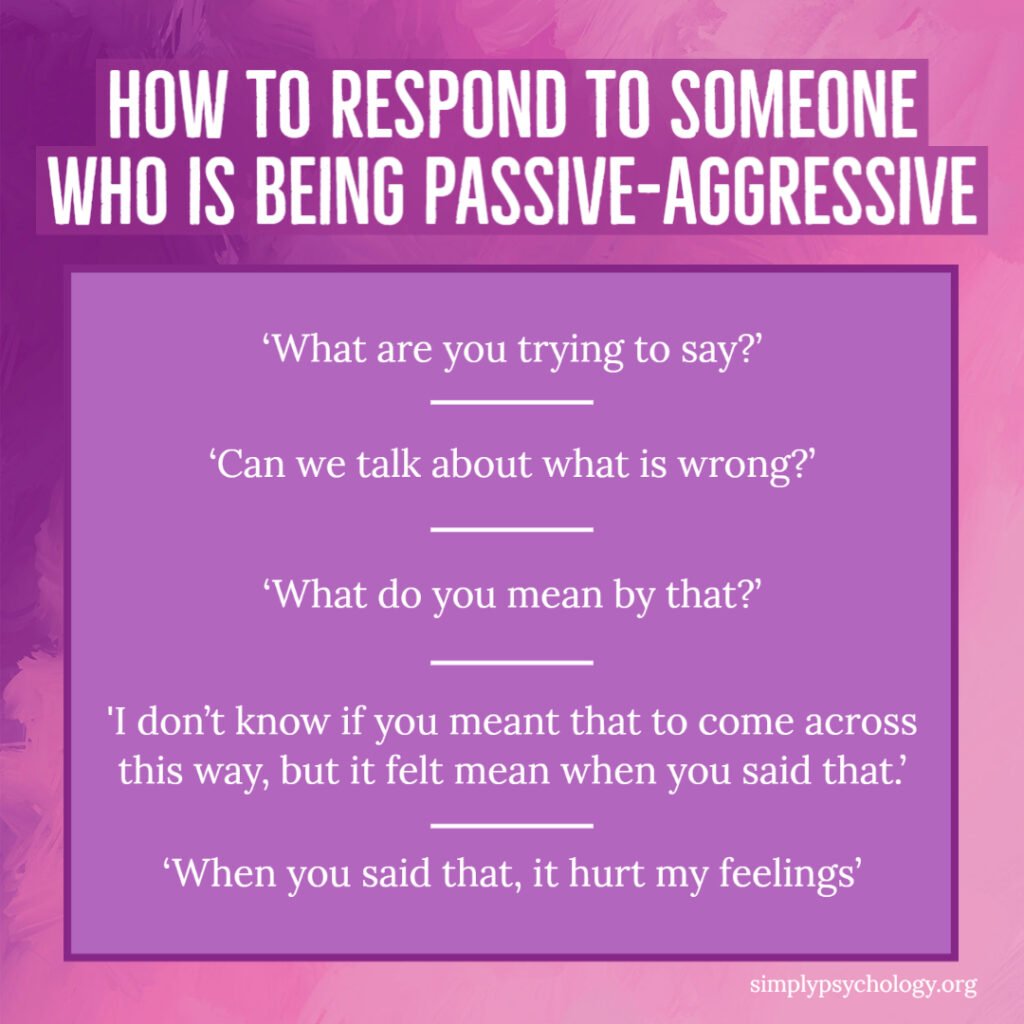On This Page:
Passive-aggressive behavior is a subtle form of expressing hostility or frustration indirectly, often through sarcasm, backhanded compliments, or avoidance of direct confrontation.
It can leave the recipient feeling confused, undermined, and frustrated, as the underlying hostility is not openly addressed but is instead disguised or implied through non-verbal cues and passive actions.
Relationships with others can begin to feel toxic if one or both parties are passive-aggressive towards each other, with neither person expressing their feelings in a healthy way.

It can feel very frustrating if one person is very open and assertive but they are not getting the same treatment from the other person. This can be especially true in romantic relationships.
A partner can become annoyed and disheartened if their partner does not feel comfortable being direct in their emotions and will instead respond with sarcasm, moody behavior, or evade any issues.
Because passive aggression is often indirect and unspoken, it can be hard to detect and address. However, some things can be done to reduce the behavior.
If someone is being passive-aggressive towards you, there are some steps you can take to respond to them in a healthy way:
Assess the situation
When first noticing passive-aggressive behavior, take time to reflect on the context and your initial hypotheses about what may be motivating it.
Is this occurring at work, home, or in another setting? Are there relationship dynamics or recent events that could be contributing factors? Setting aside time for objective analysis before responding can help prevent overreacting.

Recognize the behavior patterns
Look for patterns in the passive-aggressive behaviors to gain insight into the underlying issues. For example:
- Do they often make backhanded compliments that undercut praise? This could suggest insecurity or competitiveness.
- Is procrastination on tasks only directed at certain people? May indicate resentment or feeling threatened.
- Does their sarcasm increase when given negative feedback? Likely difficulty accepting criticism.
- Is withdrawal or the silent treatment used mainly with family? Could be long-standing poor communication patterns.
Try to have an empathetic mindset when identifying potential motivations behind the behaviors. Reflect on their perspective and what feelings may be driving their actions before reacting yourself.
Once you have some working theories about the root causes, you can have compassionate conversations to address the issues directly.
For example, if you suspect fear of conflict is leading to avoidance, you can gently ask if they have concerns about being more direct and discuss steps that can be taken to reduce the conflict (Kantor, 2002).
Remain objective
When on the receiving end of passive-aggressive behavior, it’s important not to take it personally or let it anger you. Their actions likely stem from their own difficulties with emotional expression and communication rather than anything you did.
Try to separate your own emotions from the situation in order to respond calmly and constructively. Some tips:
- Practice deep breathing to stay cool and level-headed.
- Use positive self-talk and affirmations to maintain self-confidence.
- Release tension and frustration through exercise or relaxing activities.
- Work on your emotional intelligence skills to increase your empathetic approach.
Staying grounded yourself models the type of direct communication you expect from them. It also prevents you from exacerbating the situation by reacting emotionally, which rarely improves passive-aggressive behaviors long-term.
Pete's coworker Abby ignores his requests for assistance on projects but then complains about having to do extra work. Pete takes a moment to consider Abby's perspective - perhaps she avoids requests for help because she has learned from her previous employment that accepting help for something she is capable of doing is unacceptable. Pete could approach Abby to ask if she needs any support in how projects are managed and how the workload is distributed.
Don’t overreact
If this is the first instance of passive-aggressive behavior from someone, avoid jumping to negative conclusions about their character.
Give them the benefit of the doubt and an opportunity to self-correct. People sometimes act out in moments of stress, anxiety, or frustration without realizing the impact.
Before addressing it, consider alternative perspectives:
- Could they be projecting issues from other relationships onto you?
- Are they mirroring unhealthy communication patterns from their upbringing?
- Could work or personal troubles be spilling over?
With regular passive-aggression, a pattern likely exists. But for a first occasion, gently raise it in the moment or soon after. For example, “I noticed you seemed frustrated earlier. Is there something we should talk about?”
Allow them to reflect on their behavior with an open, curious mindset rather than accusations. If it was a one-off situation, they will likely recognize the lapse and self-correct.
Have a direct discussion
Try to have a clear conversation with the passive-aggressive person, describing exactly what you have experienced and how it made you feel.
Ask if there is an issue to be addressed, and do not accuse them of anything or attack them in any way. Some ways you can begin a conversation can include saying:
- ‘What are you trying to say?’
- ‘Can we talk about what is wrong?’
- ‘What do you mean by that?’
- ‘I don’t know if you meant that to come across this way, but it felt mean when you said that.’
- ‘When you said that, it hurt my feelings.’
In this way, you are inviting them to be clearer with their communication. You are setting expectations for the relationship to be open and healthy.
The other person may not own up to anything or respond well the first time, but it may make them more aware of what they are doing.
Hana noticed that her mother made backhanded compliments about her appearance, such as saying, 'Your outfit choices are so interesting, I could never pull them off.' Rather than reacting angrily, Hana decides to have a direct conversation with her mother. She said, 'Mom, when you make undermining comments about my outfits, it hurts my feelings, even if that wasn't your intention. I know our relationship is strong enough to handle direct feedback kindly. Could we agree to do that moving forward?' Hana's mother looks surprised, not having realized the impact of her subtle criticism, apologizes, and explains she will try to be more direct with her feedback and reframe comments more constructively.
Don’t compromise your own communication skills
When responding to passive aggression, it’s vital to stick to healthy communication yourself. Don’t get pulled into toxic patterns.
Avoid veiled sarcasm, gossiping, or toxic bickering. Set clear expectations for open and direct dialogue. If emotions start running high, politely withdraw and revisit the discussion once everyone can communicate constructively.
Your passive-aggressive coworker responds to feedback with eye-rolling or sarcastic comments like “Sorry I’m not perfect,” avoid getting sucked into unhealthy back-and-forth. Instead of firing back, calmly restate that you want your working relationship to be based on transparent communication and mutual respect. Making your expectations for healthy dialogue clear proactively can prevent you from unconsciously mirroring damaging communication patterns in the heat of the moment.
Model healthy communication
You can demonstrate clear communication that serves as a model by:
- Expressing your thoughts and feelings directly using “I” statements
- Avoiding vague sarcasm or making veiled insults
- Asking genuine questions to understand their underlying motivations
- Setting boundaries diplomatically but firmly if needed
- Suggesting a break if emotions escalate to cool down
- Discussing respectful ground rules for future discussions
- Following up in writing to confirm expectations
- Practicing active listening without anger or judgment
- Finding the right time and place to have difficult conversations
Holding yourself to a high standard of assertive but compassionate communication establishes clear expectations for how to express grievances constructively. It also avoids worsening the situation by mirroring their unhealthy patterns.
Limit contact
If you have clearly set out expectations for the other person and they have not shown an adjustment in their behavior, or they reacted negatively towards you, you may have to consider whether to deal with it or distance yourself from them.
It can be very challenging to manage someone else’s behavior; you only have control over your own behavior.
To the best of your ability, it may be worth minimizing contact with the passive-aggressive person if you feel they are draining your energy to be around.
Additionally, people can try to set boundaries with passive-aggressive people. For example, they may need to discuss what is and is not acceptable behavior.
Finally, it is important for people who experience passive aggression to take care of themselves emotionally. This may include talking to a therapist or taking some time for themselves if they are feeling drained by the behavior (Kantor, 2002).
Other Ways To Cope
- Do not give in to them – if you give in to a passive-aggressive person, they will likely continue this behavior. Instead, make it clear that you expect them to communicate to you clearly; otherwise, you cannot give them what they want.
- Walk away – it is perfectly acceptable to remove yourself from a situation causing many negativities. You can start by trying to reason clearly with them first, but if they still pursue you, you can refuse to engage in any conversation until they have calmed down.
- Be assertive – passive-aggressive people try to avoid confrontations, but if you are assertive with them and explain that the way they are behaving is not okay, they may be more careful about how they are acting toward you. Make sure not to confront them in an aggressive way that sparks more aggression.
- Tell them they are being passive-aggressive – sometimes, simply calling out someone’s behavior shows that you know what they are doing. It may be the case that the person was not aware of their behavior, and calling them out can bring them some self-awareness and hopefully change this behavior.
FAQs
How does passive-aggressive behavior impact the workplace?
Passive aggression reduces team productivity through lack of collaboration, procrastination, and poor communication. It also negatively affects office culture by breeding resentment, gossip, and tension between colleagues.
How can I annoy a passive-aggressive person?
It is not advisable to try to antagonize others on purpose. Anger or retaliation often only escalates the conflict.
Instead, try to respond to passive aggression with patience, empathy, and open communication.
It’s generally more constructive to acknowledge the other person’s feelings, set boundaries if needed, and find solutions together. With mutual understanding and goodwill, passive-aggressive patterns can potentially shift over time.
How can I know if I am being passive-aggressive?
Here are some signs you may be acting passive-aggressively:
– Avoiding direct communication of your feelings, needs, or concerns and instead making subtle, indirect criticisms or negative remarks.
– Expressing resentment or hostility through nonverbal behaviors like eye rolling, sighing, or slamming things rather than openly.
– Procrastinating on tasks for others you resent or disagree with.
– Making excuses to avoid events or activities you don’t want to participate in.
– Ignoring others as punishment or giving them the silent treatment.
– Making seemingly positive statements with a hidden, cynical meaning.
The key is noticing when you are feeling resentful or upset but not expressing it openly and directly. Addressing concerns constructively rather than indirectly can help.
References
American Psychiatric Association, D. S., & American Psychiatric Association. (2013). Diagnostic and statistical manual of mental disorders: DSM-5 (Vol. 5). Washington, DC: American psychiatric association.
Kantor, M. (2002). Passive-aggression: A Guide for the Therapist, the Patient, and the Victim . Greenwood Publishing Group.
Menninger W. W. (2004). Contributions of Dr. William C. Menninger to military psychiatry. Bulletin of the Menninger Clinic, 68 (4), 277–296.
Millon, T. (1993). Negativistic (passive-aggressive) personality disorder. Journal of Personality Disorders, 7 (1), 78-85.

